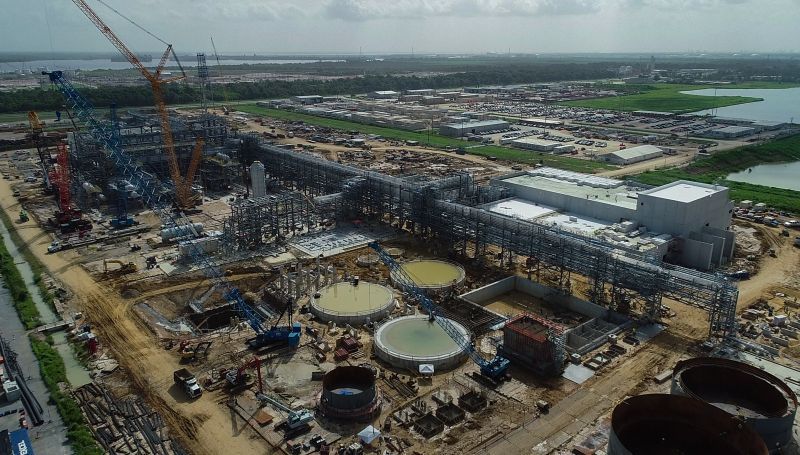
Two major deals worth over $5 billion are positioning Texas as the epicenter of North America's blue ammonia revolution. Woodside Energy and industry giants are betting big on the Lone Star State's potential to reshape global clean energy markets.
Woodside's Strategic $2.35 Billion Power Play
Australian energy giant Woodside Energy has made headlines with its bold $2.35 billion acquisition of an under-construction blue ammonia facility in Beaumont, Texas. The deal, announced in August 2024, positions the company as an early mover in a rapidly growing market.
The facility, originally developed by Netherlands-based OCI Global, is the world's first large-scale, low-carbon intensity hydrogen-based greenfield ammonia facility. Its Phase 1 is designed to produce 1.1 million tonnes per annum starting in 2025, with plans to shift to lower-carbon production by 2026.
What makes this deal strategic is its timing and location. The U.S. Gulf Coast offers unparalleled access to domestic markets and international export routes, particularly to Europe and Asia, where clean ammonia demand is surging.
>> RELATED: [x](x)

The Yara-Enbridge Partnership: Doubling Down on Texas
Not far behind, another major project is taking shape near Corpus Christi. Yara Clean Ammonia and Enbridge Inc. signed a letter of intent to develop a 1.4 million tonnes per year blue ammonia facility at the Enbridge Ingleside Energy Center.
This $2.6 to $2.9 billion project, still in the pre-FID stage, aims to reduce CO2 emissions by approximately 95% using advanced carbon capture technology. Yara, the world's largest ammonia distributor, will handle full offtake from the facility, with production targeted for 2027/2028, pending regulatory approvals.
This project underscores Texas's growing role as a hub for clean energy innovation, leveraging its infrastructure and proximity to global markets.
The Technology Behind the Transformation
Both projects hinge on cutting-edge technology to redefine ammonia production. The Woodside facility will initially use natural gas but plans to transition to lower-carbon ammonia by 2026, incorporating carbon sequestration through partnerships with Linde and ExxonMobil.
Carbon capture is the cornerstone of these projects' environmental credentials. By sequestering CO2 emissions, these facilities drastically cut their carbon footprint compared to traditional "grey" ammonia production.
These technological advancements open doors to new applications beyond agriculture:
- Marine Fuel: Blue ammonia as a zero-carbon shipping fuel
- Power Generation: Ammonia-fired power plants for grid stability
- Hydrogen Carrier: Efficient global transport of hydrogen energy
- Industrial Applications: Chemical feedstock for various industries

"Global ammonia demand is forecast to double by 2050, with lower carbon ammonia making up nearly two-thirds of total demand. This transaction positions Woodside in the growing lower carbon ammonia market."
Market Dynamics Driving the Investment Wave
The surge in blue ammonia investments reflects seismic shifts in the energy landscape. Clean ammonia supply could grow 22- to 30-fold this decade, reaching up to 32 million metric tons of capacity by 2030, according to BloombergNEF.
Key Market Data: Blue Ammonia's Explosive Growth
- Market Size: From $80 million in 2024 to projected $16.5 billion by 2034
- Growth Rate: Expected CAGR of 62.3% through 2030
- Regional Dominance: North America holds over 42% market share
- Clean Supply Growth: 22–30x increase projected this decade
North America's dominance stems from its vast natural gas resources, robust industrial infrastructure, and supportive regulatory frameworks. The Gulf Coast's proximity to shipping routes makes it a prime export hub for markets like Europe and Asia, where decarbonization policies are driving demand.

"We are creating demand pull for clean ammonia from new segments through partnerships and collaborations… Shipping fuel, power generation, hydrogen carrier, and decarbonizing fertilizers are key demand sectors for low-carbon ammonia."
— Magnus Krogh Ankarstrand, EVP Corporate Development, Yara Clean Ammonia
Agricultural Applications Drive Initial Demand
Ammonia remains a cornerstone of fertilizer production, and the shift to lower-carbon methods aligns with agriculture's sustainability push. Yet, the real excitement lies in emerging applications like ammonia as a marine fuel and in power generation, which promise to reshape energy systems.

>> In Other News: Microsoft Wants Your Poop to Lower Its Emissions
International Export Opportunities
Both Texas projects are eyeing international markets, particularly Europe and Asia, where clean ammonia demand is surging due to strict decarbonization policies. The vision includes using zero-carbon ammonia-fueled ships to deliver blue ammonia, creating a fully integrated clean energy supply chain.
Looking Ahead: Expansion Plans and Future Phases
Texas’s blue ammonia ambitions don’t stop with these initial projects. Woodside’s Beaumont facility includes plans for a second 1.1 million tonnes per annum production train (Phase 2), with a final investment decision slated for 2026 and an estimated cost of $1.2 to $1.4 billion.
| Project | Investment | Capacity | Timeline |
|---|---|---|---|
| Woodside-OCI (Beaumont) | $2.35 billion | 1.1 Mtpa | 2025 start |
| Yara-Enbridge (Corpus Christi) | $2.6–2.9 billion | 1.4 Mtpa | 2027/2028 start |
Reshaping Global Energy Markets
Combined with Woodside’s $1.2 billion acquisition of Tellurian’s Driftwood LNG facility, these investments signal Texas’s rise as a clean energy powerhouse. The state’s business-friendly environment and skilled workforce make it a natural fit for such projects.
These Texas projects are more than regional wins; they’re redefining global clean energy production and distribution. By pioneering large-scale blue ammonia facilities, they’re paving the way for decarbonization across industries like shipping, power, and manufacturing.
With a projected market growth to $16.5 billion by 2034, blue ammonia is poised to bridge the gap between fossil fuels and a cleaner energy future. Texas, with over $5 billion committed and more phases planned, is leading this charge, potentially inspiring similar developments worldwide.
Subscribe to the newsletter
Daily decarbonization data and news delivered to your inbox
Follow the money flow of climate, technology, and energy investments to uncover new opportunities and jobs.
Companies
Latest issues
-
$213 Per Tonne: Inside the Latest Multi-Pathway CDR Deal
Inside This Issue 💸 $213 Per Tonne: Inside the Latest Multi-Pathway CDR Deal 🏛️ Clean Energy Technologies Affiliate Vermont Renewable Gas Advances Regulatory Review 💧 Fusion Fuel’s BrightHy Soluti...
-
The Three-Continent Move That Redefines SAF
Wishing everyone a restful holiday season.🎄🎅🎁 Inside this Issue ✈️ Cathay Goes Global With SAF in Three-Continent Fuel Deal 🧪 Proton Ventures Partners With Barents Blue For Realization Of The Bar...
-
Can One Truck Fix Hydrogen’s Biggest Problem?
Inside This Issue 🚛 Alberta's Shared Truck Model Could Crack Hydrogen Adoption ✈️ ZeroAvia Completes Financing Round 🌾 Frontier And NULIFE Scale New Biowaste Carbon Removal Approach 🔥 WAGABOX® Of ...
Company Announcements
-
Darling Ingredients Announces Sale of Approximately $50 Million in Production Tax Credits
IRVING, Texas -- Darling Ingredients Inc. (NYSE: DAR) today announced the sale of approximately $50 million of production tax credits to a corporate buyer. These credits were generated under the In...
-
Aemetis Receives Funds From the Sale of $17 Million of Federal Clean Energy Tax Credits
CUPERTINO, Calif., Dec. 30, 2025 (GLOBE NEWSWIRE) -- Aemetis, Inc. (NASDAQ: AMTX), a renewable natural gas and renewable liquid fuels company focused on lower cost and reduced emissions products, t...
-
Deployment of up to €30 million of Partner-committed capital, to be released over time in three potential tranches of €10 million each. First project expected to be a green hydrogen production...
-
Clean Energy Technologies Affiliate Vermont Renewable Gas Advances Regulatory Review
IRVINE, CA., Dec. 29, 2025 (GLOBE NEWSWIRE) -- Clean Energy Technologies, Inc. (Nasdaq: CETY) (“CETY” or the “Company”), a clean energy technology company delivering scalable solutions in power gen...